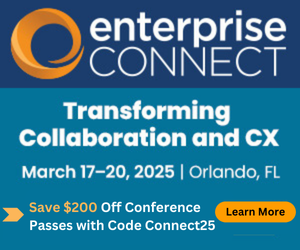Where is CEBP Hiding?Where is CEBP Hiding?
Here are some questions you should ask to help you determine whether a vendor makes a good partner for Communications-Enabled Business Processes (CEBP).
October 22, 2012

Here are some questions you should ask to help you determine whether a vendor makes a good partner for Communications-Enabled Business Processes (CEBP).
Blair Pleasant, co-founder of UCStratgies.com, recently posed this question on No Jitter while reporting from Dreamforce. The answer is as simple as it is revealing. Salesforce is focused on their own product--Customer Relationship Management (CRM)--and little else. Their path is on adding features to their CRM offering. They don't offer any other business applications software or communications capabilities. In short, Salesforce is a business silo and they are focused on their one application and adding features to it. Capabilities can be added as long as you are prepared to undertake complicated and costly integrations subject to the API's parameters and relevant security testing, not to mention multiple suppliers' product release schedules.
Similarly, traditional telecommunications vendors are focused on delivering their own Unified Communications (UC) capabilities. The components within their UC bundles are bundles of interrelated communications modalities, or in other words, UC silos. Their communications capabilities work well with each other and maybe even with productivity tool packages, but little else.
Specialized applications companies like Salesforce and telecommunications (UC) vendors purport to offer Communications Enabled Business Processes (CEBP). Neither Salesforce nor the UC vendors designed their products from the ground up with the intent to offer CEBP. Integrating their offerings all requires expensive middleware, asynchronous APIs (applications from multiple vendors don't seem to be available simultaneously) and a lot of heavy lifting from expensive VARs and consultants.
Business process software is complex. This almost mandates that the only companies that can communications-enable business processes are those companies that make business process software in the first place, like SAP and Oracle.
Creating and maintaining CEBP can be and usually is a complex undertaking to both implement and support. Companies like SAP offer native integrations between their business applications and their communications capabilities. If you are working with disparate vendors, make sure that you understand how and what applications will be working together. Implementing technology exposes risks including unexpected downtime, business interruptions, incompatibilities, limited features, clumsy functionality and higher Total Cost of Ownership. Of course, all of these directly impact customer satisfaction and organizational success.
If you're looking into CEBP, and someone says they integrate to your system, what features and functionality does that integration provide? Beyond the obvious questions of cost and time frame, make sure to ask the following questions:
1. Do the technology vendors on both sides have a formal business arrangement? What is their commitment to each other on testing new releases? Is it a mutual agreement or is one company subordinate to the other?
2. What type of API interface is it (code or web services)?
3. Are the interfaces tested and certified? By whom?
4. Who answers support questions?
5. How long has the API been in existence? If the API is new, its deficiencies may not have been uncovered yet. The longer it has been around, the more likely the issues of poor documentation or design have been addressed. In those cases, older is better. On the other hand, there are some companies that are moving away from their traditional APIs to web services. How long the older-style APIs will be supported is anyone's guess.
6. Is the documentation available? Do users feel it is adequate or too tightly constrained?
7. What capabilities are allowed by the integration?
8. What skills does it take to write to the API (e.g., XML, SOAP, Python, C) when an update is required?
9. If you are connecting your CRM or ERP system to your contact center platform, is a custom connector required to integrate the systems together?
10. In the process of selecting your contact center and CRM platform, have you researched vendors' hardware and software roadmaps to ensure future compatibility (to avoid possibly forgoing or delaying future upgrades due to incompatibilities)?
11. Do your contact center solution and provider follow best practices and industry standards?
12. Do the suppliers of your technology have a stable, growing and profitable business to ensure their long term commitment to research and development for the solutions that you are investing in?
About the Author
You May Also Like





